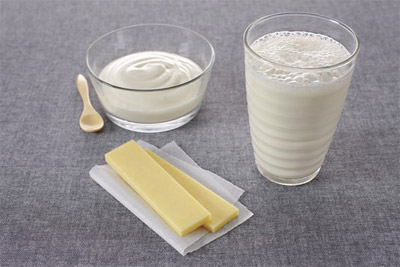Glenys Zucco National Healthy Bones Week 2013 Interview

Glenys Zucco National Healthy Bones Week 2013 Interview
Australia is struggling to cope with the burden of osteoporosis with complications arising from thinning bones on the rise.
According to Osteoporosis Australia, an average of 262 hospitalisations occurred daily across the nation (one every 5-6 minutes) as a result of osteoporotic fractures.
And bone experts predict that the stats will just keep increasing in line with our ageing population.
Osteoporosis currently affects 1.2 million Australians, with this figure expected to rise to 3 million by 2021. In addition, 6.3 million people suffer from thin bones (osteopenia) and as many as four out of five people with osteoporosis are unaware they are suffering from the degenerative bone disease.
While most people recognise the role calcium-rich dairy foods play in building and maintaining strong bones, under-consumption is widespread in Australia with eight out of ten adults failing to meet their minimum recommended intake of milk, yogurt, cheese and/or alternatives.
And, Dairy Australia believes that many Australian adults are uncertain of how many serves of dairy foods a day are now recommended for optimum health, following the introduction of Australia's new Dietary Guidelines, which have seen recommendations upped for most adults.
To help set the record straight, ahead of National Healthy Bones Week 2013 (4-10 August), Dairy Australia is putting the spotlight on the new recommendations and calcium's critical role in achieving and maintaining bone health.
'The new dietary guidelines have been based on the most up-to-date science and we now know that many Australians need to consume a lot more dairy foods," explained Dairy Australia dietitan, Glenys Zucco.
'Women over 50 years of age are now encouraged to double their intake of dairy foods from the previous recommendation of 2 serves a day to 4 serves, while all adults under 50 are urged to increase their daily dairy intake by half a serve from 2 to 2.5 serves."
In addition to highlighting the critical role dairy can play in helping curb the country's rising rate of osteoporosis, National Healthy Bones Week is also encouraging Australians to build more Vitamin D and weight bearing exercise into their daily regimen.
Leading nutritionist and Osteoporosis Australia's Healthy Bones Australia ambassador, Susie Burrell reiterates the importance of all three components in building healthy bones.
'Consuming enough dairy foods is absolutely crucial for the maintenance of healthy bones and the prevention of osteoporosis later in life. With a serving equal to 250ml of milk, 200g of yogurt or 40g of cheese, there are many healthy ways to enjoy dairy foods while also protecting your bones," Susie said.
'Add to that regular weight bearing exercise and exposure to Vitamin D (either from a safe amount of sunshine or nutritional supplements) and you'll be protecting yourself from thinning bones. You can't cure osteoporosis but unlike many other diseases, it is possible to take steps to prevent it," she explained.
For more information on National Healthy Bones Week, visit www.healthybones.com.au or join the conversation at www.facebook.com/HealthyBones and www.twitter.com/HealthyBonesAU
 Interview with Glenys Zucco
Interview with Glenys Zucco
Question: What is the main purpose behind National Healthy Bones Week?
Glenys Zucco: NHBW aims to highlight the important role of calcium rich foods, such as dairy, in the development of healthy bones and prevention of osteoporosis, along with getting enough weight bearing exercise and adequate vitamin D.
Question: Can you talk us through why Vitamin D is also a part of National Healthy Bones Week?
Glenys Zucco: Vitamin D is essential to bone health. It increases the amount of calcium that's absorbed from the gut, adjusts the amount of calcium that's in the blood and strengthens the skeleton. While there are some foods that contain Vitamin D, it is difficult to get the required amount from diet alone. Most of us get our vitamin D from safe sunlight exposure.
Question: What is the importance behind weight bearing exercise?
Glenys Zucco: Exercise is very important in building and maintaining strong bones. Regular weight-bearing, impact and resistance exercises are best for bones – and the preventative role of these exercises is probably most important during childhood and adolescence when we lay most of our bone down. But it's also important to maintain bone strength through adulthood.
Question: How can we ensure we are getting enough dairy in our diets?
Glenys Zucco: The easiest way to ensure you and your family are getting enough dairy is to include milk, cheese or yogurt at each meal.
Breakfast time is an easy opportunity for the whole family to include milk with cereal, or dollop yogurt on fresh fruit.
For the lunch box - pack a tub of yogurt or include cheese in sandwiches or wraps
For an afternoon snack, yogurt, cheese or a glass of flavoured milk is a filling snack that will keep you going until dinner.
And if all else fails - nice warm glass of milk with honey before bed has been shown to help aid sleep!
Question: How many serves of dairy are needed daily to help reduce the risk of osteoporosis? What is a serve of dairy?
Glenys Zucco: Calcium-rich dairy foods play a critical role in building and maintaining strong bones. The new Australian Dietary Guidelines have increased dairy food recommendations for most of the population and now recommend up to four serves of milk, yogurt and cheese and or alternatives a day depending on age and gender.
The minimum recommended intake of dairy foods (milk, yogurt and cheese) for women over 50 years has doubled. From 2 to 4 serves/day
For men 70 years and under, women 50 years and under and teens the minimum recommended intake of dairy foods has increased by half a serve. From 2 to 2.5 serves/day for adults and 3 to 3.5 serves/day for teens
A serve equals cup of milk (250 mL), tub of yoghurt (200 g), 2 slices of cheese (40 g)
Question: What types of low fat dairy would you suggest adults implement into their diets?
Glenys Zucco: There are lots of lower fat dairy products available if people are watching their fat intake including low-fat milk and yogurt and reduced fat cheese. For people who prefer the taste of full fat dairy foods, it is worth noting that the National Health and Medical Research Council (Australia's peak medical body) recently reviewed the Australian Dietary Guidelines and found that all types of milk, cheese and yogurt (reduced- and regular-fat) were associated with reduced risk of diseases like heart disease, stroke, type 2 diabetes and some cancers.
With this is mind, it is more important that people consume an adequate amount of the dairy foods they enjoy the most without being hung up on fat content.
Question: Is there more calcium in full fat milk in comparison to skim or low-fat milk?
Glenys Zucco: There is actually slightly more calcium in skim milk when compared to full fat milk, however the differences are not significant. 250ml of any type of milk provides basically the same amount of calcium and other bone-building nutrients, so people can choose their favourite milk based on taste.
Question: How can we ensure we are getting enough Vitamin D?
Glenys Zucco: A lot of adults go to work in the winter when it's dark and they get home when it's dark so for a large proportion of the year they're not making any vitamin D and the Australian diet is very low in vitamin D. Small amounts of vitamin D are found in foods such as fish, eggs, or milk fortified with Vitamin D. To keep levels up, head outside for you lunch breaks, and include foods such as fish, eggs, or milk fortified with Vitamin D. Guidelines on safe sun exposure can be found on http://www.healthybonesaustralia.org.au/how/sunshine/how-much-sunshine-is-enough
 Question: What are the disadvantages of not having enough Vitamin D in our diets?
Question: What are the disadvantages of not having enough Vitamin D in our diets?Glenys Zucco: Most of us get our vitamin D from sunlight exposure. In Australia we need to ensure safe sun exposure and the amount of sunlight required generally depends on the seasons, where you are and time of day. There is some good guidelines on the Healthy Bones Australia website. http://www.healthybonesaustralia.org.au/how/sunshine/how-much-sunshine-is-enough
Question: Do some yoghurts have a higher calcium content than others? How can we look out for these?
Glenys Zucco: The calcium content of different yogurts does vary between types and brands, but 200g of yogurt generally contains enough calcium to count towards one of your recommended daily serves of dairy foods. If you're interested in finding a yogurt that's towards the higher end of the calcium range, compare different brands using the calcium content (in mg) in the per 100 g column on the nutrition information panel.
Interview by Brooke Hunter
MORE



